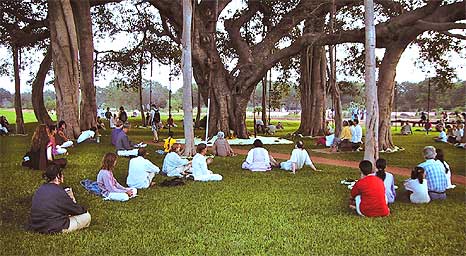| |
|
|
| |
2.4.1 The Mother in
her 1965 sketch of Auroville laid down the basic concept for the town.
This sketch delineated all the important areas of activity that will fulfil
the vision of making it a Universal Township. This concept is as practical
as it is visionary. The way in which this concept lends itself to international,
national and local thinking is extraordinary. It is as modern today as
it was innovative when it was expounded some thirty years ago. (Refer
sketches) The concept envisions close interaction between Auroville and
its surroundings to create a holistic model of development in which urban
and rural settlements will complement each other and are not seen as separate.
This concept is now being widely recommended to move towards balanced
sustainable development.
|
|
| |
|
|
| |
2.4.2
The activities of the Cultural Zone represent unending education; the
International Zone shows acceptance of Auroville's universality; the Industrial
Zone emphasises the importance of a strong economic base; the Residential
Zone gives the realisation of human oneness; and the Green Belt manifests
environmental, economic, spiritual as well as material sustainability.
The Green Belt activities help to meet the internal requirements of the
town as well as the external requirements of the region. All these activities
emanate from the central theme of Auroville: to live and work for an actual
human unity-the underlying message of all religions and philosophies.
The Divine Presence is signified in the Peace Area by the Matrimandir,
the timeless Banyan Tree and the Amphitheatre containing
the soils from all parts of India as well as from all over the world.
|
|
|
|
Meditation under the Banian tree

|
|
| |
2.4.3
Auroville, from its very inception, has embarked upon several innovations
assisting human development. The Master Plan of Auroville would break
new grounds in settlement planning which can help other cities in India
and other countries experiencing high urbanisation trends. It would demonstrate
how 'urban' and 'rural' areas can complementarily develop in an integral
and holistic way for their mutual benefit and well-being. Till recently,
urban growth was considered undesirable and all policies emphasized preventing
migration from rural areas. However, these policies have not succeeded
and urban areas are growing rapidly and becoming more and more degraded.
Presently, both national and international opinions are in favour of urbanisation,
as they have become engines of development, and emphasise policies that
promote urbanisation. Taken too far, these policies may also become untenable,
because of the heavy toll urban areas impose on limited natural resources
and their unbridled growth is liable to disrupt the food security of the
entire nation. This is why planners today are talking of establishing
strong rural-urban linkages.
|
|
| |
2.4.4
Talking about planning for agriculture and rural development, the Deputy
Chairman of the Union Planning Commission said: "Our population has just
crossed the one billion mark, and experts have projected that we would
be overtaking China by 2035 as the world's most populous country. To feed
this growing population, an additional 5-6 million tonnes of foodgrains
will need to be produced annually. In addition, we have to recognise that
balanced nutrition, which is essential for the health of our people, demands
the consumption of a wide array of food stuffs. These too must be provided
without compromising on the provision of the basic calorie requirements.
All this will have to be done in a context which is less favourable than
it used to be. To begin with, we need to recognise that the scope for
expansion of the area available for cultivation is limited. In fact there
is a possibility that cultivable area may shrink somewhat. Environmental
considerations, which are just as important for the well-being of our
people, demand that the area under forest cover be increased from the
dangerously low levels that it has reached. Demands of urbanisation and
industry too will eat into our cultivable land, though we should keep
this to the minimum. These are imperatives that we cannot ignore."*
|
|
| |
2.4.5
Auroville's development approach, while taking cognisance of the above
philosophy, goes much further. The approach of the Master Plan is to establish
that economic and human intellectual resources, which normally gravitate
to urban areas, can be effectively used to plan development more evenly
and to create an equitable and economically sound society. However, it
is common knowledge that expanding urban areas encroach not only on valuable
agricultural land but surround village settlements in such a way that
they become islands of poverty and scarce infrastructure in a neighbourhood
which is well served with better quality of infrastructure.
|
|
| |
2.4.6
It is Auroville's concept, therefore, to build a City that will economise
on land needs by introducing development approaches with an optimum mix
of densities but not sacrificing the appealing urban forms or required
amenities. The surrounding Green Belt will be a fertile zone for applied
research in the sectors of food production, forestry, soil conservation,
water management, waste management, village development and other areas
essential for sustainable development. The resulting innovative methods
can be applied/extended in both rural and urban areas everywhere, particularly
in India where the urban-rural divide is continually increasing.
* “Planning for Agriculture: Challenges and Opportunities”, K.C. Pant,
Yojana, Vol 44, no 9, Sept. 2000
|
|












